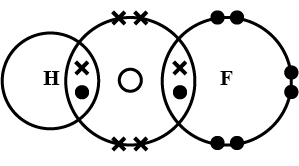
HOF is the only known molecule that contains only the elements hydrogen, oxygen and fluorine.
- Draw a dot-and cross diagram to represent the bonding in a molecule of HOF.
- Show the outer shell electrons only.
Answer
475.5k+ views
Hint: In order to give the dot-and-cross diagram to represent the bonding in HOF molecule, we must first have an idea about what a HOF is. We have to know about the atomic number and the electronic configurations of Hydrogen, oxygen and fluorine separately.
Complete step by step answer:
- Let us first understand about the HOF molecule. HOF is the chemical formula for hypofluorous acid. It is said to be the one and only oxoacid of fluorine. The fluorine atom will gain electrons from the oxygen atom to obtain a negative oxidation state. The oxidation state of oxygen in HOF is 0. The hypofluorous acid is in the solid state. The hypofluorous acid is explosive in nature.
- HOF is a molecule which contains three chemical elements in it. They are Hydrogen, oxygen and fluorine.
- Fluorine is a chemical element with an atomic number of 9 and is represented by the chemical symbol F and it is having electronic configuration is
- Oxygen is a chemical element with an atomic number of 8 and is represented by the chemical symbol O and it is having electronic configuration is
- Hydrogen is a chemical element with an atomic number of 1 and is represented by the chemical symbol H and it is having electronic configuration is
By using these valence electrons, we can draw the dot-and cross diagram of HOF.

Note: Let us see what are the other oxoacids of halogens other than hypofluorous acid.
- hypochlorous acid
- hypobromous acid
- Hypoiodous acid
- Chlorous acid
- Chloric acid
- Bromic acid
- Iodic acid
- Perchloric acid
- Perbromic acid
- Periodic acid
Complete step by step answer:
- Let us first understand about the HOF molecule. HOF is the chemical formula for hypofluorous acid. It is said to be the one and only oxoacid of fluorine. The fluorine atom will gain electrons from the oxygen atom to obtain a negative oxidation state. The oxidation state of oxygen in HOF is 0. The hypofluorous acid is in the solid state. The hypofluorous acid is explosive in nature.
- HOF is a molecule which contains three chemical elements in it. They are Hydrogen, oxygen and fluorine.
- Fluorine is a chemical element with an atomic number of 9 and is represented by the chemical symbol F and it is having electronic configuration is
- Oxygen is a chemical element with an atomic number of 8 and is represented by the chemical symbol O and it is having electronic configuration is
- Hydrogen is a chemical element with an atomic number of 1 and is represented by the chemical symbol H and it is having electronic configuration is
By using these valence electrons, we can draw the dot-and cross diagram of HOF.

Note: Let us see what are the other oxoacids of halogens other than hypofluorous acid.
- hypochlorous acid
- hypobromous acid
- Hypoiodous acid
- Chlorous acid
- Chloric acid
- Bromic acid
- Iodic acid
- Perchloric acid
- Perbromic acid
- Periodic acid
Recently Updated Pages
Master Class 11 Chemistry: Engaging Questions & Answers for Success

Master Class 11 Biology: Engaging Questions & Answers for Success

Class 11 Question and Answer - Your Ultimate Solutions Guide

Master Class 11 Business Studies: Engaging Questions & Answers for Success

Master Class 11 Accountancy: Engaging Questions & Answers for Success

Master Class 11 Computer Science: Engaging Questions & Answers for Success

Trending doubts
Which one is a true fish A Jellyfish B Starfish C Dogfish class 11 biology CBSE

State and prove Bernoullis theorem class 11 physics CBSE

1 ton equals to A 100 kg B 1000 kg C 10 kg D 10000 class 11 physics CBSE

In which part of the body the blood is purified oxygenation class 11 biology CBSE

One Metric ton is equal to kg A 10000 B 1000 C 100 class 11 physics CBSE

Difference Between Prokaryotic Cells and Eukaryotic Cells




